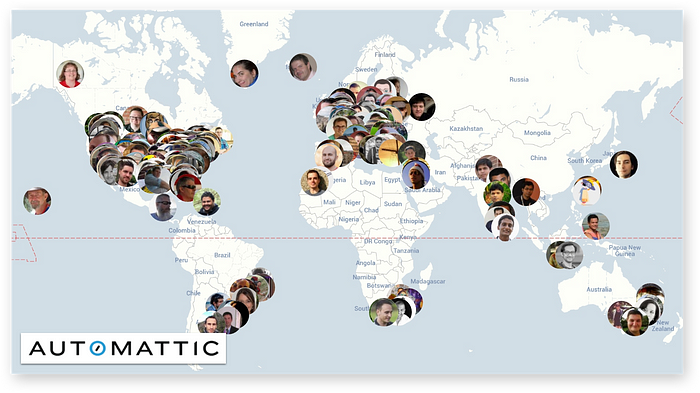It’s 2016, why are you still going to the office?
Many of today’s most successful companies allow employees to work 100% remotely. It’s especially a trend in the software and design industries, with awesome companies such as those below making the ‘digital nomad’ lifestyle possible:

There are different ways to create remote teams — from being remote-friendly to remote-first, with most remote companies favouring the latter. A remote-first team is one that embraces remote working concepts, whether employees are in the office or not. This article will explore what these concepts are and how remote-first teams are made possible using today’s collaboration tools. First though, let’s start by exploring why people prefer working remotely.
Why remote working works
Whilst skeptical managers may think remote working is a fad, the companies actively doing it are reaping the benefits in terms of employee happiness, as summed up by this appropriately titled Forbes article: “For Employee Retention, There’s No Place Like Home”.
In short:
“Remote Employee = Retention!”
Benefits of Remote Teams
Working from wherever you like offers some obvious advantages:

- No more ridiculous work commute.
- Companies aren’t restricted to the talent pool of one area.
- Employees have more time with family and friends.
- Everyone can work in a place they are most happy.
Overall, it can lead to a happier and more productive team, which is great for both employees and employers. Here’s a great post from Jason Zimdars that goes into more detail about the joys of remote working at Basecamp:
Disadvantages??
There are of course some arguments against remote work. However, Rachel Go (of Hubstaff.com) explored those problems, providing solutions for most:
We can see from Rachel’s findings that in order for distributed teams to work, it’s clear that you need to operate differently than you would as a co-located team.
Interestingly, the majority of arguments for distributed teams come from those who actually do it successfully — the ones who work at doing it right. Here’s what a few of them say:
What the people say
InVision
InVision is great example of an entirely distributed team — across 14 countries to be precise. Here’s what Matt Borgatto, Sr. Front End Engineer at InVision, had to say about the benefits of being away from the noise of the office:

“I’ve traveled and lived in six countries and two continents. I was able to do a road trip in Italy, marry my wonderful wife in Brazil, and meet with my friends in the Netherlands and United Kingdom. I love it.”
Buffer
It’s not just employees that love the remote world, but founders do to. Joel Gascoigne, founder of Buffer writes:

“Buffer is a fully distributed team. It’s a decision I had to make at the end of 2012, and it’s interesting to reflect on that decision now. I am happy to report that I am in love with the choice we made to be distributed all across the world.”
Sir Richard Branson
Let’s forget these startups for a second, and throw Sir Richard Branson’s “platonic ideal” of remote life into the mixer:

Having never worked out of an office himself, Sir Richard Branson feels people should work from wherever they want too, given they have the drive and expertise to produce.
Remote-First vs. Remote-Friendly
There are 2 notable ways companies go when creating remote teams: remote-friendly, or remote-first — with neither being exclusive of the other.
Zach Holman defines remote-first and remote-friendly perfectly in his article “Remote-First vs. Remote-Friendly”:
To summarise, a Remote-friendly company simply hires employees who live in different cities, whereas a Remote-first company operates with a workflow that embraces remote working concepts — whether team members are working remotely or from the same office.
Remote-first = fewer meetings
Remote-first teams have less traditional meetings where everyone is present at the same time, and more asynchronous communication through chat apps and ticketing systems (like GitHub issues). This not only works better across timezones, but can also create more productive teams, especially in software development, as it lets people get on with their jobs whilst also communicating more frequently and precisely.

Remote-first = futureproof
Remote-first companies can also easily hire internationally and become more remote-friendly, since the concepts of remote working are already in place to support communication across timezones. Conversely, only being remote-friendly doesn’t create the essential remote-first environment needed for a remote team to work productively, so it doesn’t set you up for the future very well.
Going all in: 100% remote
Companies such as Buffer, Automattic, GitHub and InVision are all remote-first, having learned from each other what works best. For example, Joel Gascoigne, founder of Buffer took the lessons of BaseCamp and Hubspot’s David Cancel when choosing between a being remote or co-located company.

Cancel had tried both ways — everybody working form an office, and also everyone working remotely, and offered the following advice:
- Do either one or the other, nothing part way in between.
- Don’t have 80% in the office, and 20% remote, as being in the office shouldn’t be advantageous.
His advice was one of the reasons Buffer became remote-first company from the get go. InVision has similarly been a 100% remote company from inception. Overall, working remotely shouldn’t be frowned upon or put you at any disadvantage. As Leo Widrich, Buffer Co founder said:
“You don’t want to create 2nd class citizens.”

Tools enable remote teams
As well as culture and values, tools become very important in enabling remote teams to collaborate. For example Buffer use Trello (who incidentally work remote-first too) for product management, Automattic use Slack and Zoom for chat and video calls, and InVision use InVision to design InVision. Depending on the task, there’s usually a common tool that most remote companies will use as listed below:
- Product management (e.g. Trello, GitHub)
- Chat (e.g. Slack, Hipchat)
- Video Calls (e.g. FaceTime, Appear.in, Skype, Zoom)
- Design Collaboration (e.g. Figma, InVision, RealtimeBoard, Mural)

For a more complete list of tools, check out these lists from HubSpot and Buffer:
The world of work has changed
When it comes down to it, it doesn’t matter what type of work you’re doing — as long as you’ve got a computer and an internet connection, that should be all you need. Today designers can even build prototypes collaboratively over the internet with prototyping tools such as InVision and Figma:
On the left, collaboration mode in InVision, and on the right, ‘Multiplayer Mode’ in Figma:
In all, the world of work is clearly shifting, and I think Zach Holman sums it up perfectly:
If you’re not working in a remote-first environment today, not only are you not going to have a remote-friendly environment tomorrow, but you’re going to eventually have a hard time retaining talent and keeping competitive pace in the future.
The world of work is changing. That’s just the way it is.
And we didn’t even mention Virtual Reality!

If you enjoyed this article, please sign up and recommend for more 👇






